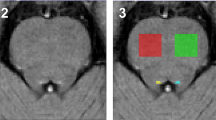Abstract
In adult, lesion-impaired rat brain receiving embryonic day 15 (E15) fetal transplants, the level of expression of glial fibrillary acidic protein (GFAP) correlates positively with choline acetyltransferase (ChAT) levels and also with measurements of successful behavioural recovery. These results suggest that glial cells may play a pivotal role in the cognitive success of socalled cholinergic-rich transplants.The objective of this study was to investigate the association between GFAP-and ChAT-staining antigens in or around cholinergicrich fetal grafts transplanted in adult cortex. An immunohistochemical fluorescent double-labelling technique was used to simultaneously identify GFAP- and ChAT-staining cells to assess whether there was a different type or distribution of cells present in these successful transplants. On brain sections of transplant area, GFAP-staining glial cells did not co-label with ChAT-staining cells. The transplant area, therefore, did not reveal a different type of cell from those seen in comparable normal cortical brain but rather a greater concentration of both GFAP- and ChAT-positive staining cells.
Similar content being viewed by others
References
Arendt T, Allen Y, Sinden J, Schugens MM, Marchbanks RM, Lantos PL, Gray JA (1988) Cholinergic-rich brain transplants reverse alcohol-induced memory deficit. Nature 332:448–450
Arendt T, Allen Y, Marchbanks RM, Schugens MM, Sinden J, Lantos PL, Gray JA (1989) Cholinergic system and memory in the rat: effects of chronic ethanol, embryonic basal forebrain transplants and excitotoxic lesions of cholinergic basal forebrain projection systems. Neuroscience 33:435–462
Assouline JG, Bosch P, Lim R, Kim IS, Jensen R, Pantazis NJ (1987) Rat astrocytes and Schwann cells in culture synthesize nerve growth factor-like neurite-promoting factors. Brain Res Dev Brain Res 31:103–118
Azmita EC, Whitaker PM (1983) Formation of a glial scar following microinjection of fetal neurons into the hippocampus or midbrain of the adult rat: an immunocytochemical study. Neurosci Lett 38:145–150
Birks R, Katz B, Miledi R (1960) Physiological and structural changes at the amphibian myoneural junction, in the course of nerve degeneration. J Physiol (Lond) 150:145–168
Dunnett SB, Toniolo G, Fine A, Ryan CN, Björklund A, Iversen SD (1985) Transplantation of embryonic ventral forebrain neurons to the neocortex of rats with lesions of nucleus basalis magnocellularis. II. Sensorimotor and learning impairments. Neuroscience 16:787–797
Eagleson KL, Raju TR, Bennett MR (1985) Motoneurone survival is induced by immature astrocytes from developing avian spinal cord. Brain Res Dev Brain Res 17:95–104
Erkman L, Wuarin L, Cadelli D, Kato AC (1989) Interferon induces astroctye maturation causing an increase in cholinergic properties of cultured human spinal cord cells. Dev Biol 132:375–388
Hansson E (1988) Astroglia from defined brain regions as studied with primary cultures. Prog Neurobiol 30:369–397
Hatten ME, Lynch M, Rydel RE, Sanchez J, Joseph-Silverstein J, Moscatelli D, Rifkin DB (1988) In vitro neurite extension by granule neurons is dependent upon astroglial-derived fibroblast growth factor. Dev Biol 125:280–289
Hodges H, Allen Y, Sinden J, Lantos PL, Gray JA (1991) Cholinergic-rich transplants alleviate cognitive deficits in lesioned rats, but exacerbate responses to cholinergic drugs. Prog Brain Res 82:347–358
Jarrard LE (1986) Selective hippocampal lesions and behaviour: implications for current research and theorizing. In: Isaacson R, Pribram K (eds) The hippocampus, vol 4. Plenum, New York, pp 93–126
Kesslak JP, Nieto-Sampedro M, Globus J, Cotman CW (1986) Transplants of purified astrocytes promote behavioral recovery after frontal cortex ablation. Exp Neurol 92:377–390
Kesslak JP, Walencewicz A, Calin L, Nieto-Sampedro M, Cotman CW (1988) Hippocampal but not astrocyte transplants enhance recovery on a forced choice alternation task after kainate lesions. Brain Res 454:347–354
Koelle GB (1955) The histochemical identification of acetylcholinesterase in cholinergic, adrenergic and sensory neurons. J Pharmacol Exp Ther 114:167–184
Kozlova EN (1989) Differentiation of neuroglia in embryonic neocortical transplants of rats, placed in the brains of adult animals: an immunohistochemical investigation. Exp Morphol 445–448
Kozlova EN (1990) Differentiation of neural and glial cells of neocortical transplants placed into the brain of adult rats (in Russian). Ontogenez 21(4): 388–394
Manthorpe M, Rudge JS, Varon S (1986) Astroglial cell contributions to neuronal survival and neuritic growth. In: Fedoroff S, Vernadakis A (eds) Astrocytes, vol. 3. Academic, London, pp 315–376
Massarelli R, Mykita S, Sorrentino G (1986) The supply of choline to glial cells. In: Fedoroff S, Vernadakis A (eds) Astrocytes, vol 2. Academic, London, pp 155–178
Mathewson AJ, Berry M (1985) Observations on the astrocyte response to a cerebral stab wound in adult rats. Brain Res 327:61–69
Patel AJ, Hunt A (1989) Regulation of production by primary cultures of rat forebrain astrocytes of a trophic factor important for the development of cholinergic neurons. Neurosci Lett 99:223–228
Patterson PH, Potter DD, Furshpan EJ (1978) The chemical differentiation of nerve cells. Sci Am 239:38–417
Reier PJ (1986) Gliosis following CNS injury: the anatomy of astrocytic scars and their influences on axonal elongation. In: Fedoroff S, Vernadakis A (eds) Astrocytes, vol 3. Academic, London, pp 263–324
Smith LM, Ebner FF (1986) The differentiation of non-neuronal elements in neocortical transplants. In: Das GD, Wallace RB (eds) Neural transplantation and regeneration. Springer, Berlin Heidelberg New York, pp 81–101
Takamiya Y, Kohsaka S, Toya S, Otani M, Tsukada Y (1988) Immunohistochemical studies on the proliferation of reactive astrocytes and the expression of cytoskeletal proteins following brain injury in rats. Brain Res Dev Brain Res 38:201–210
Wets KM, Sinden J, Hodges H, Allen Y, Marchbanks RM (1991) Specific brain protein changes correlated with behaviourally effective brain transplants. J Neurochem 57:1661–1670
Author information
Authors and Affiliations
Rights and permissions
About this article
Cite this article
Wets, K.M., Patel, S.N., Sinden, J. et al. Immunoidentification of cellular brain proteins associated with cognitive recovery in brain transplants. Exp Brain Res 97, 466–470 (1994). https://doi.org/10.1007/BF00241540
Received:
Accepted:
Issue Date:
DOI: https://doi.org/10.1007/BF00241540




